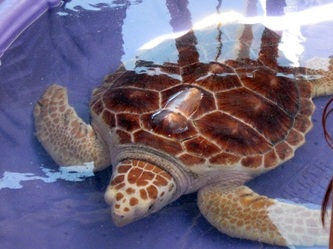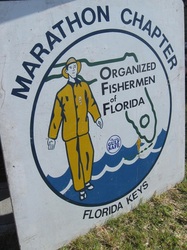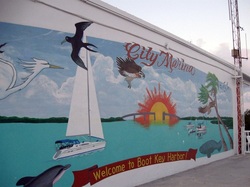
Marathon has been full of activities since we arrived in early March. The weather has been warm, the harbor friendly, and the facilities comfortable. We keep running into cruisers from Dinner Key and points north, as well as having met some people shoreside through activities like the Seafood Festival and the Waterway Net. It’s been a good start to the month.
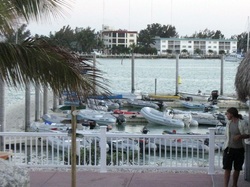
Expanded dinghy dock
Something Old, Something New
It’s been interesting checking out the changes or lack thereof in Marathon, since we last visited 3 years ago. First of all, there are the improvements in the marina – new showers, laundry, a huge new dinghy dock, WiFi, 2 flat screen TV’s in the marina with comfortable theater chairs, lots of tables and plugs for using computers on shore. And as we’ve walked US 1 east and west of the marina, we’ve noted the new along with the familiar. They still have 25 cent wings at The Hurricane. There’s still a Home Depot, Public and Winn Dixie nearby. Keys Fisheries still sells a lobster reuben, but they have opened a new bar called Keys Drinkeries. West Marine has moved and expanded, but you can’t dinghy there any more. The Overseas Bar and Grill which closed when we were last here still stands empty. The Cruisers Net is still a fixture every morning at 9am. They have Meet n Greets every Wednesday, which are now more organized than before. The bus to Key West still runs, but the price has gone up to a $1.50 each way. You can still dinghy to the marinas at the harbor entrance for gas and get free ice. Marathon Community UMC is still welcoming transients like us and having a fish fry at the end of March.
And most telling, the building across the street from Publix is still under construction after 3 years having passed.
It’s been interesting checking out the changes or lack thereof in Marathon, since we last visited 3 years ago. First of all, there are the improvements in the marina – new showers, laundry, a huge new dinghy dock, WiFi, 2 flat screen TV’s in the marina with comfortable theater chairs, lots of tables and plugs for using computers on shore. And as we’ve walked US 1 east and west of the marina, we’ve noted the new along with the familiar. They still have 25 cent wings at The Hurricane. There’s still a Home Depot, Public and Winn Dixie nearby. Keys Fisheries still sells a lobster reuben, but they have opened a new bar called Keys Drinkeries. West Marine has moved and expanded, but you can’t dinghy there any more. The Overseas Bar and Grill which closed when we were last here still stands empty. The Cruisers Net is still a fixture every morning at 9am. They have Meet n Greets every Wednesday, which are now more organized than before. The bus to Key West still runs, but the price has gone up to a $1.50 each way. You can still dinghy to the marinas at the harbor entrance for gas and get free ice. Marathon Community UMC is still welcoming transients like us and having a fish fry at the end of March.
And most telling, the building across the street from Publix is still under construction after 3 years having passed.

The new dinghy dwarfs our little Zodiac.
Growing Up
We’ve been used to having one of, if not the smallest dinghy in the harbor with our little 7+ foot Zodiac inflatable. (It is the largest dinghy we could find that fit on our foredeck.) However, as we look to move to a smaller, trailerable boat, we’ve been considering other alternatives. The one that we kept coming back to was a Portabote. This is a folding dinghy that will collapse to only 4” wide for stowing. Bob and Trish on Pogopelli (their Tonic 23), had used one for several years and were able to store it on deck. When we arrived in Marathon, we discovered several of them for sale. Dave started checking them out, and we even were lucky enough to be offered a ride in one by Bob on Pogopelli one windy night that might have gotten us pretty wet on our Zodiac. We stayed dry as could be. We were convinced.
Although our preference was for a 10ft boat, we couldn’t pass up a deal on a 12 ft boat that was in great condition. Once the deal was closed, it didn’t take long before we had moved our outboard over to the new Portabote. We began cruising the harbor in all conditions without worrying about getting wet or how much stuff we had on board. What a dream! To get ahead of any growth on the bottom, we took her over to the beach on Sisters Creek to clean and wash the outer hull. Since she is so much longer and there are no secure attachment points at the bow, Dave made a new, longer steel cable to enable us to lock the boat and motor when we leave the dinghy for a long time at the dock.
We still have to fold her up and load her on deck, which will be the bigger challenge. In the meantime, we’ve put our little Zodiac up for sale. So it looks like we’ve graduated from having the smallest dinghy in the harbor to one of the biggest. Not something we would have expected when we started out this year.
We’ve been used to having one of, if not the smallest dinghy in the harbor with our little 7+ foot Zodiac inflatable. (It is the largest dinghy we could find that fit on our foredeck.) However, as we look to move to a smaller, trailerable boat, we’ve been considering other alternatives. The one that we kept coming back to was a Portabote. This is a folding dinghy that will collapse to only 4” wide for stowing. Bob and Trish on Pogopelli (their Tonic 23), had used one for several years and were able to store it on deck. When we arrived in Marathon, we discovered several of them for sale. Dave started checking them out, and we even were lucky enough to be offered a ride in one by Bob on Pogopelli one windy night that might have gotten us pretty wet on our Zodiac. We stayed dry as could be. We were convinced.
Although our preference was for a 10ft boat, we couldn’t pass up a deal on a 12 ft boat that was in great condition. Once the deal was closed, it didn’t take long before we had moved our outboard over to the new Portabote. We began cruising the harbor in all conditions without worrying about getting wet or how much stuff we had on board. What a dream! To get ahead of any growth on the bottom, we took her over to the beach on Sisters Creek to clean and wash the outer hull. Since she is so much longer and there are no secure attachment points at the bow, Dave made a new, longer steel cable to enable us to lock the boat and motor when we leave the dinghy for a long time at the dock.
We still have to fold her up and load her on deck, which will be the bigger challenge. In the meantime, we’ve put our little Zodiac up for sale. So it looks like we’ve graduated from having the smallest dinghy in the harbor to one of the biggest. Not something we would have expected when we started out this year.
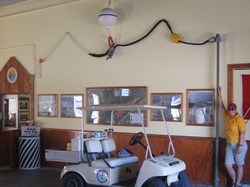
Cathy is dwarfed by the helix anchor that holds the harbor’s moorings.
Stormy Weather
We were off the boat one morning when a promised storm rolled through the harbor, the black clouds having blocked out a beautiful blue sky within less than an hour. The storm was a nasty squall with winds up to 50 knots (~ 58 mph), but only one clap of thunder as it blew itself out over the harbor for a couple of hours. Orion was unaffected, other than a little water that had come in through a couple of open hatches in the head and galley (oops!). However, our friends on Celise / Spirit were not so lucky, having suffered a lightning strike (remember that one clap of thunder?) in the water nearby. As a result, they lost all of their electronics, their inverter and some other electrical components, leaving them without a means of charging their batteries. They called an electrician (who was the one who diagnosed the problem as a lightning strike), and he was on board shortly after the call. He inventoried the damage and placed an order for the necessary replacement components, expecting them to arrive the next Tuesday (the storm passed through on Thursday). However, the batteries still needed to be charged in the interim.
We were off the boat one morning when a promised storm rolled through the harbor, the black clouds having blocked out a beautiful blue sky within less than an hour. The storm was a nasty squall with winds up to 50 knots (~ 58 mph), but only one clap of thunder as it blew itself out over the harbor for a couple of hours. Orion was unaffected, other than a little water that had come in through a couple of open hatches in the head and galley (oops!). However, our friends on Celise / Spirit were not so lucky, having suffered a lightning strike (remember that one clap of thunder?) in the water nearby. As a result, they lost all of their electronics, their inverter and some other electrical components, leaving them without a means of charging their batteries. They called an electrician (who was the one who diagnosed the problem as a lightning strike), and he was on board shortly after the call. He inventoried the damage and placed an order for the necessary replacement components, expecting them to arrive the next Tuesday (the storm passed through on Thursday). However, the batteries still needed to be charged in the interim.

Dave and Renee relax on Orion
Dave had offered his assistance, and when Cort accepted, Dave was over in minutes, helping him wire his solar panels so they could charge the batteries. He also suggested they could reduce the load by putting ice in the fridge, which allowed them to turn it off for the interim. By later that afternoon, Cort and Carolyn were feeling much better and had relaxed enough that they accepted an invitation for frozen drinks on Orion. Lunar Sea accepted as well, and we enjoyed a re-telling of storm stories as we laughed and relaxed in Orion’s cockpit. On Monday night, still limping along on their solar charger, Celise / Spirit returned the favor. With the time change, we were able to gather a couple of hours before sunset and not strain their power situation by turning on lights.
By Tuesday afternoon, the electrician had come and gone, having installed the inverter and some of the replacement components, allowing them to charge their batteries again. There was more to do, but the worst was over. They were very grateful to Dave for his help, which is part of what this life is all about.
By Tuesday afternoon, the electrician had come and gone, having installed the inverter and some of the replacement components, allowing them to charge their batteries again. There was more to do, but the worst was over. They were very grateful to Dave for his help, which is part of what this life is all about.
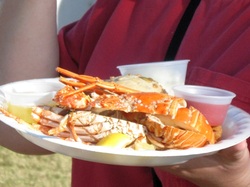
Lobster awaits at the Seafood Festival
Could someone pass the lobster?
The Marathon Seafood Festival arrives on the second weekend of March each year. So, we arrived in the harbor just in time to experience it again. As we did three years ago, we volunteered to work at a booth. However, this time we were lucky to be assigned to one of the food booths. We were scheduled to work the last work slot of the festival, so after handing out a dizzying number of sea food platters (Cathy) and slicing a bushel of lemons (Dave), the food began to run out and the work died down. (Of course, we were allowed to fortify ourselves with some pieces of fish and bits of lobster along the way – just to keep our energy up.) While the festival wound down, we closed out our shift by clearing trash and cleaning up (being offered some sweets by the dessert booth as we passed through). This wasn’t too bad.
Just before closing, a decision was made to sell the remaining cases of lobsters by themselves. Since most of the volunteers were gone by that time, we found ourselves scrambling to prepare takeout trays and then started selling lobster hand over fist. In the space of 20 minutes, we took in over a thousand dollars. (We even bought a few for ourselves.) As we cleaned up once again, we were offered the leftover frozen smoothies from the vendor down the way. They hit the spot. With our work done, we headed back to the marina, took showers and made our way back to the boat, looking forward to enjoying the lobsters we had worked so hard for.
The Marathon Seafood Festival arrives on the second weekend of March each year. So, we arrived in the harbor just in time to experience it again. As we did three years ago, we volunteered to work at a booth. However, this time we were lucky to be assigned to one of the food booths. We were scheduled to work the last work slot of the festival, so after handing out a dizzying number of sea food platters (Cathy) and slicing a bushel of lemons (Dave), the food began to run out and the work died down. (Of course, we were allowed to fortify ourselves with some pieces of fish and bits of lobster along the way – just to keep our energy up.) While the festival wound down, we closed out our shift by clearing trash and cleaning up (being offered some sweets by the dessert booth as we passed through). This wasn’t too bad.
Just before closing, a decision was made to sell the remaining cases of lobsters by themselves. Since most of the volunteers were gone by that time, we found ourselves scrambling to prepare takeout trays and then started selling lobster hand over fist. In the space of 20 minutes, we took in over a thousand dollars. (We even bought a few for ourselves.) As we cleaned up once again, we were offered the leftover frozen smoothies from the vendor down the way. They hit the spot. With our work done, we headed back to the marina, took showers and made our way back to the boat, looking forward to enjoying the lobsters we had worked so hard for.
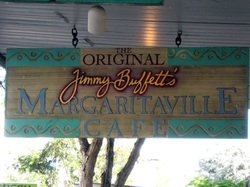
Key West – What do you mean it’s Mardi Gras?
Soon after arriving in Marathon, we knew we wanted to catch the bus to Key West. We had read that we could learn more about the regulations for the Dry Tortugas there at the Florida Eco-Discovery Center. So, with Dave and Renee, we set out early one Tuesday morning to catch the bus outside the marina on US 1. The hour-long ride was uneventful, and we disembarked at the Publix where we were planning to transfer to the downtown shuttle. However, we had some shopping to do, so we started walking toward downtown, stopping at Sears and Radio Shack along the way. By the time we made it to Miami Subs, we were hot, thirsty, and hungry, so we ate an early lunch, cooled off, and studied the local map to decide where to go next.
Soon after arriving in Marathon, we knew we wanted to catch the bus to Key West. We had read that we could learn more about the regulations for the Dry Tortugas there at the Florida Eco-Discovery Center. So, with Dave and Renee, we set out early one Tuesday morning to catch the bus outside the marina on US 1. The hour-long ride was uneventful, and we disembarked at the Publix where we were planning to transfer to the downtown shuttle. However, we had some shopping to do, so we started walking toward downtown, stopping at Sears and Radio Shack along the way. By the time we made it to Miami Subs, we were hot, thirsty, and hungry, so we ate an early lunch, cooled off, and studied the local map to decide where to go next.

We were far enough along on the way downtown, that we abandoned the search for the bus and instead decided to walk the rest of the way. We ended up at the Southernmost Point monument, where it proclaims we are closer to Cuba (90 miles) than to the mainland (100 miles). Since there was a line that had formed to get your picture taken at this spot, it didn’t take us long to realize we were at the height of the tourist season. We knew we were in Spring Break territory for a number of schools before we left Marathon, but it took us a little longer to put together that this Tuesday was the day before Ash Wednesday, making it (that’s right) Mardi Gras. We obviously were one of the few who were out of touch on this point. The bars on Duval Street were heavily advertising their parties for the night (free beads!). We hoped to be well on our way home before too much craziness took over the downtown streets.

We finally made it to the Eco-Discovery Center, which is on the waterfront near the lighthouse. Although they had some info on the Dry Tortugas, it didn’t really justify the trip, since most of it we already knew. We spent a little time checking out their exhibits on the Keys marine life, watched the movie and then moved on. Dave and Renee spent the time instead at the famous Green Parrot Bar, which is where we caught up with them. As they finished their beers, we struck up a conversation with a couple who were down here on vacation and had caught a glimpse of the SV-Orion logo on our shirts. On a sailboat?, they asked, and it went from there.

Street performer in Mallory Square
After wondering Duval Street for a while longer, we were starting to get hungry again and got a recommendation to try Alonzo’s Oyster Bar, where we had a great meal on half-price appetizers. The service was excellent as well. By the time we were done, it was time for the sunset performances at Mallory Square. We took in a few of these before we decided we needed to start heading for the bus stop to make our way back. We detoured by a Radio Shack, so Dave and Renee could buy a new stereo component for their boat. With this large box in hand our progress was slowed, and we arrived at the bus stop just after the bus we wanted had passed, causing us to wait almost 45 minutes for the next one. This late in the evening, the only downtown bus running went the long way back to Publix, taking an hour to make the circuit. Luckily, we got on one stop before the Duval St pickup, where the bus filled to standing room only, not all of whom were completely sober. This was to be the same circumstance for the next 2 hours of bus rides all the way back to Marathon. It was therefore a weary foursome that made our way back to our dinghies around 11pm. We were glad to get back to Orion and call it a day. Key West is great place to visit, but maybe next time we’ll make sure it’s not Mardi Gras before getting on the bus.

Chuck, aka ND7K
“Ham”-ming it Up
Whenever we move the boat, we check in on the Waterway Net, a Ham radio network of cruisers and former cruisers. They keep track of check-ins and, in case of emergency, will let loved ones know where we are. One of the anchors of the Waterway Net is Chuck, call sign ND7K, a Marathon resident, whose powerful transmitter makes him the go-to guy when no one else can be heard on the net. Although we’ve spoken to Chuck numerous times on the net, we’d never met him in person. With our arrival in Marathon, we had our chance to do so at the weekly Waterway Net lunch. We checked in the first Wednesday after our arrival in the harbor and Chuck offered to pick us up and take us to the restaurant.
The lunch was held at Lazy Daze at Marathon Marina, with a beautiful view of the water out toward the 7-Mile bridge. We were joined by about 25 other club members and had a good time putting names and faces to Ham call signs. Chuck was a gracious host, and it was fun learning his background (e.g., as a cattle rancher, he once traded half a steer for a barrel of anchor chain), as well as that of the others around us. We’ve been back a second time and will likely return until we have to leave. Until then, this is Kilo India 4 Whiskey India Tango, clear.
Dry Tortugas or Not?
We have had a couple of weeks of easterly winds that just won’t let up. It’s great for getting to the Dry Tortugas, but not so great for getting back. So, we’ll keep looking for the weather and hope it will open up before too long. In the meantime, Marathon’s not a bad place to be.
Whenever we move the boat, we check in on the Waterway Net, a Ham radio network of cruisers and former cruisers. They keep track of check-ins and, in case of emergency, will let loved ones know where we are. One of the anchors of the Waterway Net is Chuck, call sign ND7K, a Marathon resident, whose powerful transmitter makes him the go-to guy when no one else can be heard on the net. Although we’ve spoken to Chuck numerous times on the net, we’d never met him in person. With our arrival in Marathon, we had our chance to do so at the weekly Waterway Net lunch. We checked in the first Wednesday after our arrival in the harbor and Chuck offered to pick us up and take us to the restaurant.
The lunch was held at Lazy Daze at Marathon Marina, with a beautiful view of the water out toward the 7-Mile bridge. We were joined by about 25 other club members and had a good time putting names and faces to Ham call signs. Chuck was a gracious host, and it was fun learning his background (e.g., as a cattle rancher, he once traded half a steer for a barrel of anchor chain), as well as that of the others around us. We’ve been back a second time and will likely return until we have to leave. Until then, this is Kilo India 4 Whiskey India Tango, clear.
Dry Tortugas or Not?
We have had a couple of weeks of easterly winds that just won’t let up. It’s great for getting to the Dry Tortugas, but not so great for getting back. So, we’ll keep looking for the weather and hope it will open up before too long. In the meantime, Marathon’s not a bad place to be.

